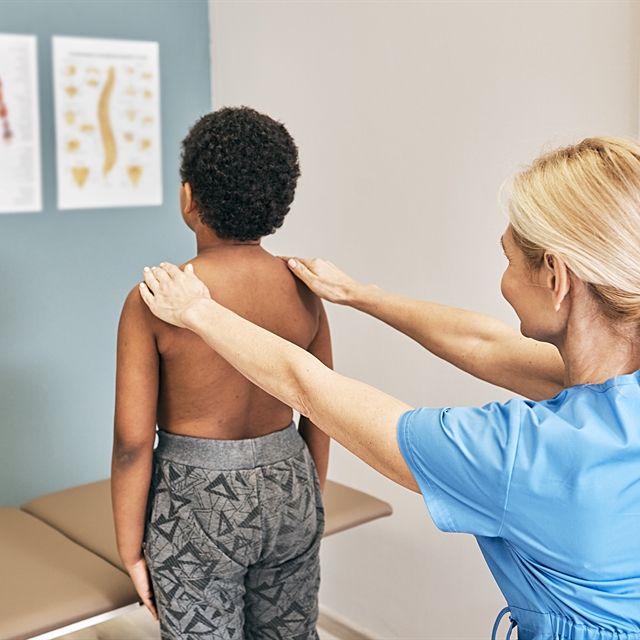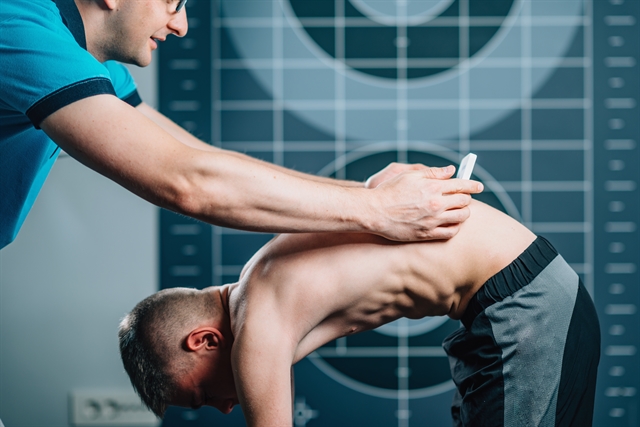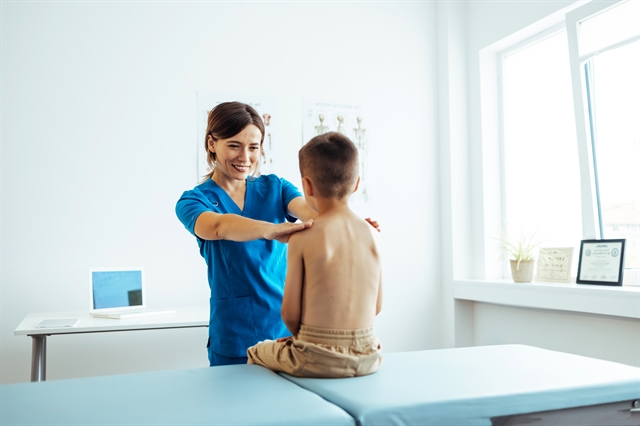Scoliosis
What is Scoliosis?
Scoliosis is a condition of side-to-side spinal curves that measure greater than 10º. On an x-ray, the spine of a person with scoliosis looks more like an "S" or a "C" than a straight line. These curves may cause your shoulders or hips to be uneven, depending on where your curves are located in your spine.
Idiopathic scoliosis is by far the most common kind of scoliosis. "Idiopathic" means that the cause is not known, and it develops most frequently in preteens or teen-agers. Adolescent idiopathic scoliosis (AIS) is 10 times more common in girls than boys!
1
Infantile idiopathic scoliosis is found in children ages 0 to 3.
2
Juvenile idiopathic scoliosis is found in in children ages 4 to 10.
3
Adolescent idiopathic scoliosis is found in adolescents ages 11 to 18.
4
Adult idiopathic scoliosis is found in patients older than 18.
Do I Have Scoliosis?
Doctors can detect scoliosis by performing a physical examination of your back:

You stand in a relaxed position with your arms at your sides and the doctor will view you from behind looking for curvature of the spine, shoulder blade asymmetry, waistline asymmetry and any trunk shift.

You will also bend forward at the waist to allow the doctor to observe the rotation of the the spine; scoliosis can create a rib prominence in the upper back and/or a flank or waist prominence in the lower back.
Suspected Scoliosis
If scoliosis is suspected following this simple examination, the doctor will usually order X-rays of the entire spine from the neck to the pelvis (back and side views).
Present Scoliosis
If scoliosis is present, the doctor will measure the spine’s curves and provide you with a number, in degrees, to help describe the scoliosis.
Confirmed Scoliosis
Once the presence of scoliosis is confirmed, your doctor will discuss treatment options with you or refer you to a specialist.
Treatment options may include:
Routine monitoring of the curvature (and in some case, physical therapy) as long as it remains minimal;
Wearing a brace to try to stop the curve(s) from progressing;
Surgery for patients with major curves causing discomfort or other health problems.
Types of Scoliosis?
Early Onset Scoliosis
Early Onset Scoliosis refers to spine curvature that is present before 10 years of age. When untreated, severe EOS may be associated with an increased risk of early death due to heart and lung disease.
Syndromic Scoliosis
Highly variable based on underlying syndrome and size of scoliosis. Usually not painful, but when severe can cause discomfort and/or pain with seating.
Neuromuscular Scoliosis
Neuromuscular curves are often associated with pelvic obliquity, a condition in which the child's pelvis is unevenly tilted with one side higher than the other.
Thoracic Insufficiency Syndrome (TIS)
TIS affects the chest's function of moving air in and out of the lungs. Symptoms include labored breathing, increased breathing rate, and extreme breathlessness and fatigue.
Congenital Scoliosis
Due to improper formation and separation of vertebrae that has no known cause. Usually requires monitoring by a spine specialist. It will require surgery in many cases.
Idiopathic Scoliosis
Patients with AIS typically have no pain or neurologic abnormalities (like weakness) and exhibit a normal appearance when viewed from the side.
Frequently Asked Questions
What is scoliosis?
Scoliosis is a common condition that affects many children and adolescents. Simply defined, scoliosis is a sideways curve of the spine that measures greater than 10 degrees on X-ray. Instead of a straight line down the middle of the back, a spine with scoliosis curves, sometimes looking like a letter "C" or "S." Some of the bones in a scoliotic spine also may have rotated slightly, making the person’s waist or shoulders appear uneven.
What causes scoliosis?
In more than 80 percent of the cases, a specific cause is not found and such cases are termed “idiopathic,” meaning “of undetermined cause.” Conditions known to cause scoliosis are congenital spinal column abnormalities (abnormally formed vertebrae present at birth), neurological disorders, muscular diseases, genetic conditions (e.g., Marfan’s syndrome, Down syndrome) and a multitude of other causes such as infections or fractures involving the spine.
What does not cause scoliosis?
There are many common misconceptions and incorrect assumptions. To set the record straight, scoliosis does not come from carrying a heavy book bag or other heavy things, athletic involvement, poor sleeping or standing postures, lack of calcium, or minor leg length difference.
How early should children be screen for scoliosis
Children can be screened at any age, although idiopathic scoliosis is more commonly discovered during a child's growth spurt (10 to 15 years old). The Scoliosis Research Society recommends that girls be screened twice, at 10 and 12 years of age (grades 5 and 7), and boys once at 12 or 13 years of age (grades 8 or 9). A great deal of controversy exists as to the benefits of school screening.
How does a doctor diagnose scoliosis?
When the patient is examined from the rear and asked to bend forward until the spine is horizontal, one side of the back may appear higher than the other. This test, called the Adams test, is a very sensitive test for scoliosis; it is therefore the most frequent screening test for scoliosis. Determining whether or not you have scoliosis is best done by a physician who performs a physical examination of your back. The examination is done with you standing in a relaxed position with your arms at your sides. The physician will view you from behind looking for curvature of the spine, shoulder blade asymmetry, waistline asymmetry and any trunk shift. You will then bend forward at the waist and the physician will view your back once again to look for the rotational aspect of the scoliosis in the upper part of the back (rib prominence) or in the lower part of your back (flank or waist prominence). Following this simple examination, the physician will usually obtain initial radiographs of the spine viewed from the back and the side to see the entire spine from the neck to the pelvis. If scoliosis is present, the physician will measure the radiographs and provide you with a numerical value, in degrees, to help describe the scoliosis.
Will physical therapy help my scoliosis?
It has not been proven that physical therapy can help people with scoliosis. Different physical therapy methods have been designed to offset the effects of scoliosis, and improve the shape and look of your body. There is some scientific evidence to show that physical therapy may help you to look straighter and improve your breathing. However, there is little evidence to show that physical therapy is more effective than doing nothing in stopping the curve from getting worse during growth. If you have spinal problems in addition to your scoliosis (such as back pain), your doctor may prescribe physical therapy to address your specific needs.
If I need scoliosis surgery, what can I expect?
Surgical treatment is reserved for curves which are generally greater than 50 degrees for adolescent patients and adults. Surgery can be performed for smaller curves if the appearance of the curvature is bothersome to the patient or if symptoms are associated with the scoliosis in the adult patient. The goals of surgical treatment are to obtain curve correction and to prevent curve progression by fusing the spine at the optimum degree of safe correction of the deformity. This is generally achieved by placing metal implants onto the spine that are then attached to rods, which correct the spine curvature and hold it in the corrected position until fusion, or knitting of the spine elements together. Please visit the Surgery page for further information on what to expect before, during and after surgery.

Find A Specialist
Although SRS does not recommend or refer physicians, members that may be available for a consultation are listed on the physician locator.
Patient Stories
Explore the stories to learn more about patients with various spinal disorders.
